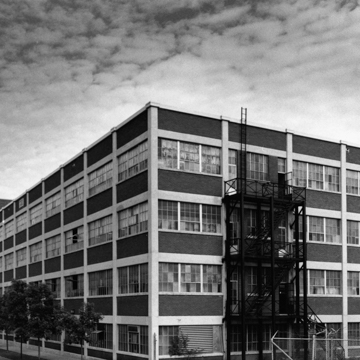By the 1890s, logging had drastically depleted the Northwoods pineries, and La Crosse’s days as a sawmill town were numbered. Local boosters sought new industries to fill the vacuum. One was the La Crosse Rubber Mills, which the city’s Board of Trade helped Albert Hirshheimer and Michael Funk found in 1897. The firm soon ranked among the city’s largest employers, making rainwear and, after 1906, footwear. In 1913, it built a three-story factory, wedged between the railroad tracks and the river bottoms in the industrial suburb of North La Crosse. The complex grew in several stages over the next seventeen years.
The factory’s reinforced-concrete framing and generous banks of windows reflect the type of “daylight factory” developed by Albert Kahn in Detroit in the first decades of the twentieth century. Kahn’s influence is most evident in the initial building here, a V-shaped factory, which extends three bays along St. Andrew Street and thirteen along the railroad grade (now a parking lot). Brick spandrels and giant multipane windows span the voids between concrete piers, creating a grid. Around 1916 the company added a fourth story. Later additions included a sixteen-bay wing (1916), a twelve-bay wing (1923) stretching east along the street, and a long wing (1919) reaching northeast along the tracks. Though these additions match the original block, their windows are somewhat shorter. A one-story wing added to the north end of the complex (1927) assumes a different appearance. Brick pilasters separate its large rectangular windows, rising through the roofline to create a twenty-eight-bay rhythm.















